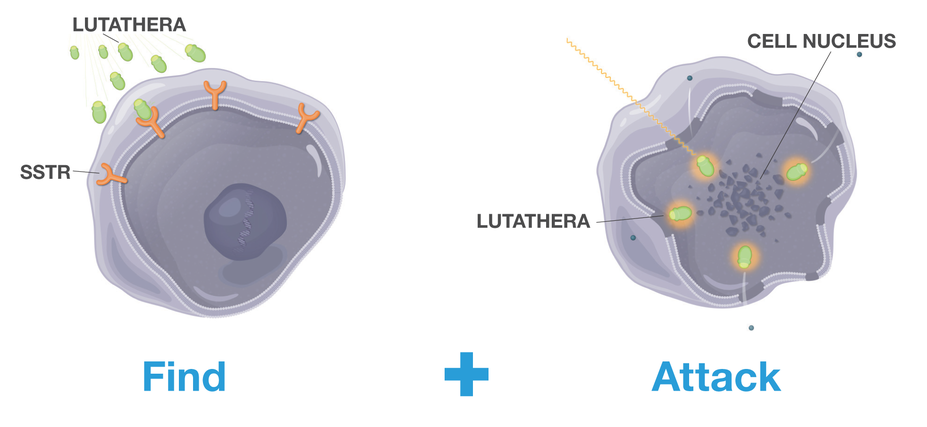
LUTATHERA delivers targeted radiation to NET cells
LUTATHERA is a type of treatment called peptide receptor radionuclide therapy (PRRT). PRRTs can target a specific protein on cancer cells. They then deliver a small but powerful dose of radiation to those cancer cells.
Most GEP-NETs have SSTRs on the surface of their cells. LUTATHERA harnesses and delivers the power of radiation to SSTR+ NET cells. This happens in 2 steps.
How LUTATHERA works
LUTATHERA finds NET cells by targeting the SSTRs on the surface of the cells.
LUTATHERA enters the NET cells and attacks from within. It releases radiation inside the cells, destroying them.
LUTATHERA targets and attacks cells with SSTRs but radiation also affects neighboring cells.
Understanding targeted radiation with LUTATHERA
It’s understandable to have questions about the targeted radiation LUTATHERA delivers. Learning how it works in your body can help you feel more informed about the treatment.
After each infusion, your care team will tell you when you can leave the treatment center
You will have to wait until the amount of radiation in your body decreases before you can leave the treatment center. After each infusion, your care team will monitor the radiation in your body and tell you when it is safe to leave.
The radiation travels no more than 2.2 millimeters
Beta radiation from LUTATHERA spreads no more than 2.2 millimeters (about 1/10 of an inch) in your tissue. This is similar to the thickness of a nickel coin.
The amount of radiation exposure to those around you is less than a chest x-ray
In a clinical trial, the average total exposure to caregivers in the 5 days after a treatment was less than the exposure from 1 chest x-ray.
Radiation from LUTATHERA does not stay in your body long
Within 2 days, most of the radiation will leave your body.
Within 14 days, more than 99% of the radiation will be gone.
GEP-NET, gastroenteropancreatic neuroendocrine tumor; NET, neuroendocrine tumor; STTR, somatostatin receptor; SSTR+, somatostatin receptor-positive.

